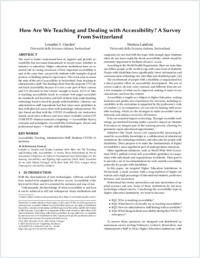How are we teaching and dealing with accessibility? : a survey from Switzerland
- Soares Guedes, Leandro ORCID Istituto Dalle Molle di studi sull'intelligenza artificiale (IDSIA), Facoltà di scienze informatiche, Università della Svizzera italiana, Svizzera
- Landoni, Monica ORCID Istituto Dalle Molle di studi sull'intelligenza artificiale (IDSIA), Facoltà di scienze informatiche, Università della Svizzera italiana, Svizzera
- 2020
Published in:
- DSAI '20: Proceedings of the 9th International Conference on Software Development and Technologies for Enhancing Accessibility and Fighting Info-exclusion. - 2020, p. 141-146
English
The need to better understand how to support and provide accessibility has increased dramatically in recent years, whether in industry or education. Higher education institutions have an essential role in raising awareness of how important accessibility is and, at the same time, can provide students with examples of good practice in building inclusive experiences. This work aims to assess the state of the art of accessibility in Switzerland, from teaching to administrative staff. Our findings show that the majority (77%) do not teach accessibility because it is not a core part of their courses and 21% declared to don't know enough to teach. 62,5% of who is teaching accessibility teach to evaluate web pages accessibility standards and heuristics and half of them help understanding technology barriers faced by people with disabilities. Likewise, our administrative staff respondents had four times more guidelines to deal with physical access than with technology enhancements. We also found out that with the COVID-19 outbreak, our instructors mainly used extra software and were more available online.
- Collections
- Language
-
- English
- Classification
- Computer science and technology
- License
-
Rights reserved
- Open access status
- green
- Identifiers
-
- DOI 10.1145/3439231.3440610
- ARK ark:/12658/srd1328197
- Persistent URL
- https://n2t.net/ark:/12658/srd1328197
Statistics
Document views: 81
File downloads:
- SoaresGuedes_2020_DSAI: 226
